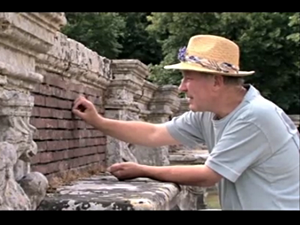
Film: The hunt for a tiny Mediterranean snail.
Papillifera bidens (Linnaeus 1758)
 Film: The hunt for a tiny Mediterranean snail. |
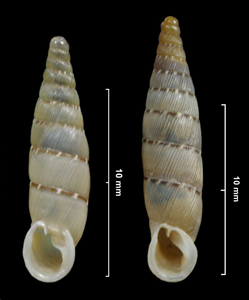 Subspecies of the Italian door snail. Left: Papillifera bidens bidens ( Mainland Italy), right: Papillifera bidens affinis (Sicily). Picture: H. Nordsieck (Source). |
The Italian door snail, Papillifera bidens, has an interesting story to tell in more than one regards: In the news it became well known especially because it was found in England in two places independent from one another. First the Italian door snail was found on the land of the Cliveden House manor in Berkshire, better known as the site of the Profumo affair in the 1960s. In Berkshire the snails had been introduced with a balustrade taken from the Villa Borghese in Rome in 1896 and transported to England.
At the second place they inhabit on the British Isles, the small island of Brownsea at the Dorset coast, southwest of Bournemouth, the Italian Door snail had been known for a longer time. It had been discovered and identified in 1993. It is assumed, this snail population had been introduced with rocks from Greece in the 1880s.
This means, the introduction of the Italian door snail to England took place twice independently from different places of origin.
Papillifera bidens originally is found in two subspecies: Papillifera bidens bidens on the Italian mainland as far south as northern Calabria, and Papillifera bidens affinis in southern Calabria, on Sicily and Malta. Both subspecies can be clearly distinguished by the form of their apertural lip which is almost always attached in bidens and almost detached in affinis (see picture on the left):
From five distinct characters, the malacologist H. Nordsieck (not the author of the present homepage) was able to reconstruct the distribution of the species ain the Mediterranean - the French southern coast, the Balearic Islands, the Tunisian north coast, Greece, the Istanbul region (there as well the snail is associated with buildings of various ages (Örstan, 2006)) and the island of Rhodes.
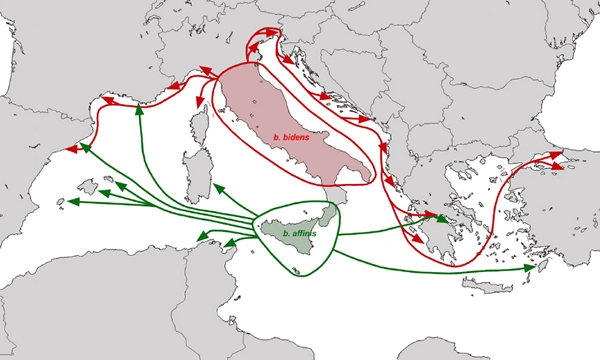 The distribution of the two subspecies of Papillifera bidens, P. b. bidens and P. b. affinis, in Italy and the adjacent Mediterra- nean. Map: H. Nordsieck. (Source). |
There are intermediate forms between both subspecies, for example near Toulon, on the Sorrento peninsula in Campania and on Malta.
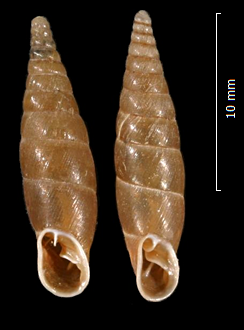 Cochlodina incisa. Picture: F. Welter-Schultes. |
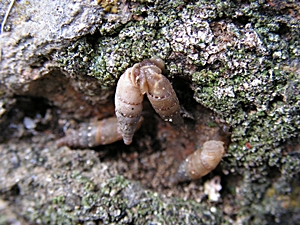 Italian door snails (Papillifera bidens), two specimens mating. Picture: Sigrid Hof (Source). |
It is assumed that Papillifera bidens has been distributed in most cases by man (ship traffic of Romans and Venetians).
Those findings, so far, await confirmation by DNA-morphological research. Likewise, little is known about the genetics of the English populations of the Italian door snail.
The Italian door snail is among the few species of door snails, which are quite frequent on one hand, and besides, mainly present in habitats formed by man, especially near the coast.
Why Papillifera bidens is connected to anthropogenous habitats to such an extent, so far lacks explanation: "The distribution area, quite exceptionally vast for a clausiliid species, as well as its connection to anthropogenous habitats, so for has not been explained either. P. bidens is a paradigmatic example for modern malacology doing very little for the knowledge of some species" (H. Nordsieck [1], in translation).
Finally there is also a very interesting discussion about the correct nomenclature of the Italian door snail. In 2005 [2] the English findings of the species around Cliveden House were still described as Papillifera papillaris. This scientific name is based on Otto Friedrich Müller's publication of 1774 (see also: "The Cornu Problem"). But the species name bidens by Linné from the year 1758 is older and therefore valid, an opinion shared by the ICZN (2007: 195: Opinion 2176, September 2007) - the species name papillaris is not to be maintained. There is, however, another publication by Kadolsky (2009) supporting the opinion that Linné originally meant the species Cochlodina incisa with his description of Turbo bidens and therefore this name could not be used for Papillifera bidens, which is a completely other species of door snail.
H. Nordsieck, however, supports the opinion that this opinion is neither comprehensible nor correct, as Cochlodina incisa only externally is vaguely similar. Besides, Linné could have made an error. He described the species as Turbo bidens, but apparently he made an error when he cited an illustration by Gualtieri, because the description of the species does not correspond with the respective illustration. As a result, the name of the Italian door snail as absolutely correct in its current form.
|
|
Kadolsky, D. (2009): Turbo bidens Linnaeus 1758 (Gastropoda: Clausiliidae) misidentified for 250 years. – Journal of Conchology, 40 (1): 19-30. | |
|
|
Gümüş, B. A. (2006): Additional data on the distribution of Papillifera papillaris (O. F. Müller, 1774) (Gastropoda: Pulmonata: Stylommatophora: Clausiliidae) in Istanbul, Turkey. The Archeo+Malacology Group Newsletter, (10): page 6 - 7. (PDF). Accessed 26.05.2011. | |
|
|
Hartmut Nordsieck: Papillifera bidens (Linné 1758) (Clausiliidae, Alopiinae), a common, but little known species (Link). Accessed 17.06.2011. | |
| Hartmut Nordsieck: Die letzte große Clausilien-Exkursion nach Italien, eine Fahrt der klimatischen Extreme. (Link). Accessed 11.06.2012. | ||
|
|
Örstan, A. (2006): The clausiliid snail Papillifera papillaris in Istanbul, Turkey. The Archeo+Malacology Group Newsletter, (9): page 6 - 7. (PDF). Accessed 26.05.2011. | |
|
|
Sharpe, J. R. (2005): Papillifera papillaris (Gastropoda: Clausiliidae): a new record for Britain. The Archeo+Malacology Group Newsletter, (7): page 6 - 7. (PDF). Accessed 26.05.2011. |
![]() Richard Black:
Snail hides from march of history.
Richard Black:
Snail hides from march of history.
![]() Wikipedia:
Papillifera bidens. Accessed 26.05.2011.
Wikipedia:
Papillifera bidens. Accessed 26.05.2011.
![]() Guardian:
Tiny Mediterranean snail 'hitchhiked' to UK in Victorian times. Accessed
26.05.2011.
Guardian:
Tiny Mediterranean snail 'hitchhiked' to UK in Victorian times. Accessed
26.05.2011.
![]() Forum Natura Mediterraneo:
bidens - papillaris. La saga continua.
Forum Natura Mediterraneo:
bidens - papillaris. La saga continua.